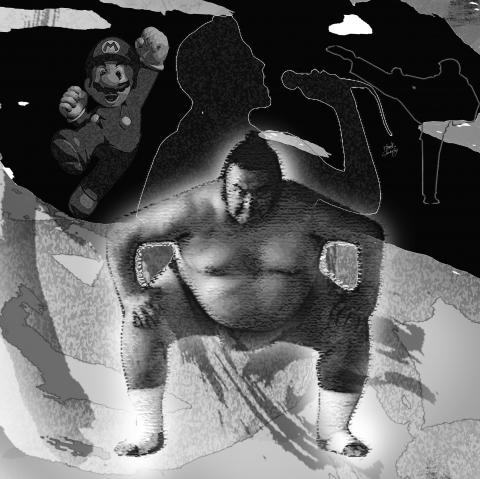The Japanese have successfully enthralled Westerners by exporting all manner of popular distractions — karaoke, manga, Super Mario Land, karate — but sumo wrestling remains, squatting stubbornly in its birthplace, refusing to leave. Valiant attempts have been made to popularize the sport outside Japan, but to little avail.
James Bond pops into a sumo stadium in You Only Live Twice, but predictably only spends a few seconds watching the action before his attention span’s dick squirms toward a beautiful female spy situated nearby. In the 1990s, Britain’s Channel 4 television optimistically dangled televised sumo tournaments in front of its audience, like a waiter making a cheery-yet-doomed attempt to interest a diner in the kangaroo-and-lemon pie instead of cod and chips. It did not catch on.
The problem is this: To a Westerner, sumo looks inherently silly. Fat men in nappies: That is our gut reaction. Skim a languid eye over it and it scarcely resembles a sport at all. At first glance it is an excuse to show off the participants’ bodies, with particular emphasis on the buttocks — a bit like beach volleyball with diabetic bus drivers. At second glance, all that pushing and shoving looks less like a martial art and more like a fight in a pub doorway. There is, of course, rather more to it than that, but you have to sit down and pay attention for some time before you unlock it.

Despite a string of recent match-fixing scandals denting its popularity, sumo remains Japan’s national sport, so when visiting Tokyo during one of the professional sumo tournaments, it would be churlish not to at least try to get a seat. The national stadium, or Kokugikan, is situated in the Ryogoku District: You cannot miss it during a tournament thanks to the hundreds of brightly colored nobori flags outside.
During a tournament, the various bouts and interspersed ceremonies go on all day, and if you are a tourist rather than a committed sumo fan, things only really get interesting in the final few hours, so plan your day accordingly.
Our seats were located up in the upper balconies, which meant upon entering I was treated to an impressive view of the entire arena. Being largely allergic to sport of any kind, it is easy for me to forget just how popular it is, and since I have only been to a few live sporting events in my life, I am always surprised and impressed by their sheer scale.
The sumo tournament was no exception to the rule — I had to catch my breath as I walked in — but the surrounding air of ancient ritual gave it an additional unreal tinge. The combination of crowds, costumes and ceremony made it feel like a cross between a cricket ground, a theater and a cathedral.
I was determined to try to enjoy the sport itself. However, first I had to get to my seat. I figured I would saunter in suavely, like James Bond had, but there were two crucial differences between me and James Bond. First, he was visiting a different stadium (the current one opened in 1985). Second, Bond arrived during the summer, so he did not walk in wearing an absurdly huge overcoat that rendered him slightly less maneuverable than a dead hovercraft.
Many of the first-floor seats are actually tatami mats the spectators sit upon, cross-legged. Up in the circle, you clamber along an insanely narrow row into a tiny seat with an arm table attached to it — handy for resting a bento box and a beer on (it even has a bottle opener attached), but infuriating when you are trying to squeeze into position while wearing a coat the size of a dinghy.
Still, once you are sitting down, you can concentrate on the action itself. At first, the ceremony-to-sport ratio in sumo seems maddening, but that is partly because an outsider will find it hard to separate ritual from universal sporting admin. For instance, several matches were preceded by a small parade of men clutching brightly colored banners with mysterious text printed all over them: It was only when I noticed one banner had a photo of a cookie on it that I realized these were adverts from commercial sponsors.
Which is not to say there is not a lot of ceremonial time-wasting: There is. The wrestlers spend several minutes slowly adjusting their belts, stretching, slapping their thighs, squatting, stomping and tossing purifying salt into the ring before launching themselves at one another for a battle that often lasts mere seconds. Once you get over the initial novelty value, the bouts feel completely underwhelming — until, that is, you witness your first surprise victory. A wrestler teetering on the brink of the ring, on the verge of an apparently inevitable loss, somehow regains his balance, deftly lolls to the side, pushes back and sends his bewildered opponent tumbling to the ground. The crowd roars and you are roaring too.
From this point on, the protracted ceremonial buildup to each fight actively adds to the tension. What is more, the fights seem to slow down in your head and make sense. The climax of the final bout on the day we visited was a major upset: The crowd went wild, hurling seat cushions into the air in a display of surprised delight.
Many retired sumo wrestlers open restaurants serving chankonabe — the meal they cook on a daily basis at the stables; a one-pot dish consisting of meat, tofu, vegetables and stock. Our guide in Tokyo, Tyler Palma, took us to Kotogaume, a chankonabe restaurant run by a retired sumo wrestler of the same name. Kotogaume means “harp plum,” apparently, which goes to show that even after translation, some phrases stubbornly refuse to make sense.
The chankonabe bubbles away in the center of the table while you sit cross-legged on the tatami floor. I say “sitting”: in my case, I mean shifting awkwardly in a vain attempt to get comfortable. James Bond I am not. Fortunately the chankonabe makes up for the loss of blood to the thighs.
Once you have eaten most of the meat and veg, noodles are added to the stock for a second helping. It is simple, tasty fare, and until the noodles enter the fray it feels surprisingly healthy, too, which makes it hard to believe this is the stuff sumo wrestlers are built from — although they do tend to guzzle it in huge quantities, washed down with beer and followed by a long doze. You know. Like darts players probably do.
As we leave, Kotogaume himself appears, and bids us farewell. We thank him and hop in a cab (in Japan, cab doors open automatically as you approach). The Japanese have a peculiar custom when saying goodbye: It is polite for them to stand rooted to the spot, watching you vanish into the distance until you are a dot on the horizon. I snuck glances back at Kotogaume as the car drove off. Being a sumo, you can see him from quite a distance. Sure enough he stood there; a content, overgrown cherub, smiling at our cab until eventually we turned a corner.
Having lived through former British prime minister Boris Johnson’s tumultuous and scandal-ridden administration, the last place I had expected to come face-to-face with “Mr Brexit” was in a hotel ballroom in Taipei. Should I have been so surprised? Over the past few years, Taiwan has unfortunately become the destination of choice for washed-up Western politicians to turn up long after their political careers have ended, making grandiose speeches in exchange for extraordinarily large paychecks far exceeding the annual salary of all but the wealthiest of Taiwan’s business tycoons. Taiwan’s pursuit of bygone politicians with little to no influence in their home

In 2025, it is easy to believe that Taiwan has always played a central role in various assessments of global national interests. But that is a mistaken belief. Taiwan’s position in the world and the international support it presently enjoys are relatively new and remain highly vulnerable to challenges from China. In the early 2000s, the George W. Bush Administration had plans to elevate bilateral relations and to boost Taiwan’s defense. It designated Taiwan as a non-NATO ally, and in 2001 made available to Taiwan a significant package of arms to enhance the island’s defenses including the submarines it long sought.
US lobbyist Christian Whiton has published an update to his article, “How Taiwan Lost Trump,” discussed on the editorial page on Sunday. His new article, titled “What Taiwan Should Do” refers to the three articles published in the Taipei Times, saying that none had offered a solution to the problems he identified. That is fair. The articles pushed back on points Whiton made that were felt partisan, misdirected or uninformed; in this response, he offers solutions of his own. While many are on point and he would find no disagreement here, the nuances of the political and historical complexities in
Taiwan faces an image challenge even among its allies, as it must constantly counter falsehoods and misrepresentations spread by its more powerful neighbor, the People’s Republic of China (PRC). While Taiwan refrains from disparaging its troublesome neighbor to other countries, the PRC is working not only to forge a narrative about itself, its intentions and value to the international community, but is also spreading lies about Taiwan. Governments, parliamentary groups and civil societies worldwide are caught in this narrative tug-of-war, each responding in their own way. National governments have the power to push back against what they know to be